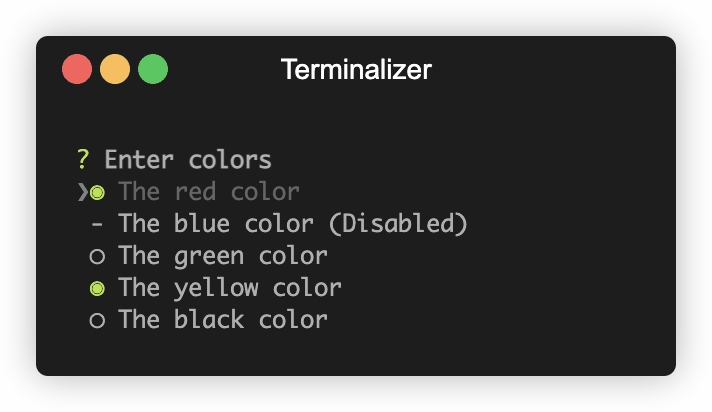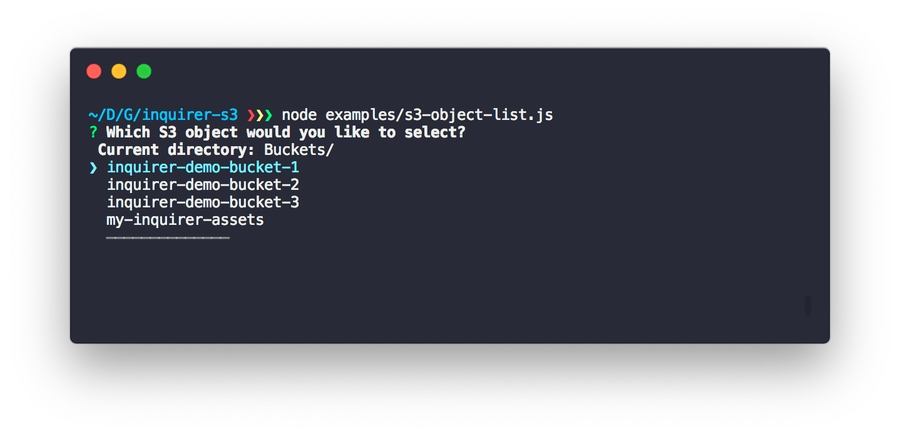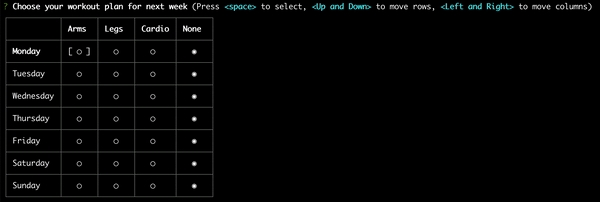inquirer
Inquirer.js
A collection of common interactive command line user interfaces.
Table of Contents
Goal and Philosophy
Inquirer.js strives to be an easily embeddable and beautiful command line interface for Node.js (and perhaps the "CLI Xanadu").
Inquirer.js should ease the process of
providing error feedback
asking questions
parsing input
validating answers
managing hierarchical prompts
Note:
Inquirer.jsprovides the user interface and the inquiry session flow. If you're searching for a full blown command line program utility, then check out commander, vorpal or args.
Installation
Examples (Run it and see it)
Check out the packages/inquirer/examples/ folder for code and interface examples.
Methods
inquirer.prompt(questions) -> promise
Launch the prompt interface (inquiry session)
questions (Array) containing Question Object (using the reactive interface, you can also pass a
Rx.Observableinstance)returns a Promise
inquirer.registerPrompt(name, prompt)
Register prompt plugins under name.
name (string) name of the this new prompt. (used for question
type)prompt (object) the prompt object itself (the plugin)
inquirer.createPromptModule() -> prompt function
Create a self contained inquirer module. If you don't want to affect other libraries that also rely on inquirer when you overwrite or add new prompt types.
Objects
Question
A question object is a hash containing question related values:
type: (String) Type of the prompt. Defaults:
input- Possible values:input,number,confirm,list,rawlist,expand,checkbox,password,editorname: (String) The name to use when storing the answer in the answers hash. If the name contains periods, it will define a path in the answers hash.
message: (String|Function) The question to print. If defined as a function, the first parameter will be the current inquirer session answers. Defaults to the value of
name(followed by a colon).default: (String|Number|Boolean|Array|Function) Default value(s) to use if nothing is entered, or a function that returns the default value(s). If defined as a function, the first parameter will be the current inquirer session answers.
choices: (Array|Function) Choices array or a function returning a choices array. If defined as a function, the first parameter will be the current inquirer session answers. Array values can be simple
numbers,strings, orobjectscontaining aname(to display in list), avalue(to save in the answers hash), and ashort(to display after selection) properties. The choices array can also contain aSeparator.validate: (Function) Receive the user input and answers hash. Should return
trueif the value is valid, and an error message (String) otherwise. Iffalseis returned, a default error message is provided.filter: (Function) Receive the user input and answers hash. Returns the filtered value to be used inside the program. The value returned will be added to the Answers hash.
transformer: (Function) Receive the user input, answers hash and option flags, and return a transformed value to display to the user. The transformation only impacts what is shown while editing. It does not modify the answers hash.
when: (Function, Boolean) Receive the current user answers hash and should return
trueorfalsedepending on whether or not this question should be asked. The value can also be a simple boolean.pageSize: (Number) Change the number of lines that will be rendered when using
list,rawList,expandorcheckbox.prefix: (String) Change the default prefix message.
suffix: (String) Change the default suffix message.
askAnswered: (Boolean) Force to prompt the question if the answer already exists.
loop: (Boolean) Enable list looping. Defaults:
true
default, choices(if defined as functions), validate, filter and when functions can be called asynchronously. Either return a promise or use this.async() to get a callback you'll call with the final value.
Answers
A key/value hash containing the client answers in each prompt.
Key The
nameproperty of the question objectValue (Depends on the prompt)
confirm: (Boolean)input: User input (filtered iffilteris defined) (String)number: User input (filtered iffilteris defined) (Number)rawlist,list: Selected choice value (or name if no value specified) (String)
Separator
A separator can be added to any choices array:
The constructor takes a facultative String value that'll be use as the separator. If omitted, the separator will be --------.
Separator instances have a property type equal to separator. This should allow tools façading Inquirer interface from detecting separator types in lists.
Prompt types
Note:: allowed options written inside square brackets (
[]) are optional. Others are required.
List - {type: 'list'}
Take type, name, message, choices[, default, filter, loop] properties. (Note that default must be the choice index in the array or a choice value)
Raw List - {type: 'rawlist'}
Take type, name, message, choices[, default, filter, loop] properties. (Note that default must be the choice index in the array)
Expand - {type: 'expand'}
Take type, name, message, choices[, default] properties. (Note that default must be the choice index in the array. If default key not provided, then help will be used as default choice)
Note that the choices object will take an extra parameter called key for the expand prompt. This parameter must be a single (lowercased) character. The h option is added by the prompt and shouldn't be defined by the user.
See examples/expand.js for a running example.
Checkbox - {type: 'checkbox'}
Take type, name, message, choices[, filter, validate, default, loop] properties. default is expected to be an Array of the checked choices value.
Choices marked as {checked: true} will be checked by default.
Choices whose property disabled is truthy will be unselectable. If disabled is a string, then the string will be outputted next to the disabled choice, otherwise it'll default to "Disabled". The disabled property can also be a synchronous function receiving the current answers as argument and returning a boolean or a string.
Confirm - {type: 'confirm'}
Take type, name, message, [default] properties. default is expected to be a boolean if used.
Input - {type: 'input'}
Take type, name, message[, default, filter, validate, transformer] properties.
Input - {type: 'number'}
Take type, name, message[, default, filter, validate, transformer] properties.
Password - {type: 'password'}
Take type, name, message, mask,[, default, filter, validate] properties.
Note that mask is required to hide the actual user input.
Editor - {type: 'editor'}
Take type, name, message[, default, filter, validate] properties
Launches an instance of the users preferred editor on a temporary file. Once the user exits their editor, the contents of the temporary file are read in as the result. The editor to use is determined by reading the $VISUAL or $EDITOR environment variables. If neither of those are present, notepad (on Windows) or vim (Linux or Mac) is used.
Use in Non-Interactive Environments
prompt() requires that it is run in an interactive environment. (I.e. One where process.stdin.isTTY is true). If prompt() is invoked outside of such an environment, then prompt() will return a rejected promise with an error. For convenience, the error will have a isTtyError property to programmatically indicate the cause.
User Interfaces and layouts
Along with the prompts, Inquirer offers some basic text UI.
Bottom Bar - inquirer.ui.BottomBar
This UI present a fixed text at the bottom of a free text zone. This is useful to keep a message to the bottom of the screen while outputting command outputs on the higher section.
Reactive interface
Internally, Inquirer uses the JS reactive extension to handle events and async flows.
This mean you can take advantage of this feature to provide more advanced flows. For example, you can dynamically add questions to be asked:
And using the return value process property, you can access more fine grained callbacks:
Support (OS Terminals)
You should expect mostly good support for the CLI below. This does not mean we won't look at issues found on other command line - feel free to report any!
Mac OS:
Terminal.app
iTerm
Windows (Known issues):
cmd.exe
Powershell
Cygwin
Linux (Ubuntu, openSUSE, Arch Linux, etc):
gnome-terminal (Terminal GNOME)
konsole
Know issues
Running Inquirer together with network streams in Windows platform inside some terminals can result in process hang. Workaround: run inside another terminal. Please refer to the https://github.com/nodejs/node/issues/21771
News on the march (Release notes)
Please refer to the GitHub releases section for the changelog
Contributing
Unit test Unit test are written in Mocha. Please add a unit test for every new feature or bug fix. npm test to run the test suite.
Documentation Add documentation for every API change. Feel free to send typo fixes and better docs!
We're looking to offer good support for multiple prompts and environments. If you want to help, we'd like to keep a list of testers for each terminal/OS so we can contact you and get feedback before release. Let us know if you want to be added to the list (just tweet to @vaxilart) or just add your name to the wiki
License
Copyright (c) 2016 Simon Boudrias (twitter: @vaxilart) Licensed under the MIT license.
Plugins
Prompts
autocomplete
Presents a list of options as the user types, compatible with other packages such as fuzzy (for search)

checkbox-plus
Checkbox list with autocomplete and other additions

datetime
Customizable date/time selector using both number pad and arrow keys
![]()
inquirer-select-line
Prompt for selecting index in array where add new element

command Simple prompt with command history and dynamic autocomplete
inquirer-fuzzy-path
Prompt for fuzzy file/directory selection.

inquirer-emoji
Prompt for inputting emojis.

inquirer-chalk-pipe
Prompt for input chalk-pipe style strings

inquirer-search-checkbox Searchable Inquirer checkbox
inquirer-search-list
Searchable Inquirer list

inquirer-prompt-suggest
Inquirer prompt for your less creative users.

inquirer-s3
An S3 object selector for Inquirer.

inquirer-autosubmit-prompt Auto submit based on your current input, saving one extra enter
inquirer-file-tree-selection-prompt
Inquirer prompt for to select a file or directory in file tree

inquirer-table-prompt
A table-like prompt for Inquirer.

Last updated
Was this helpful?